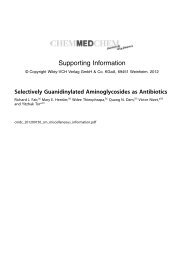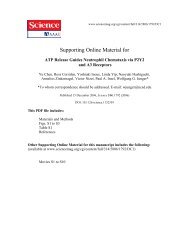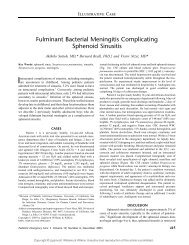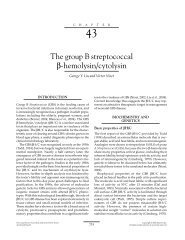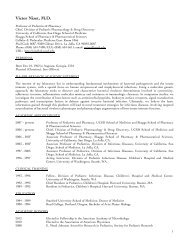BACTERIAL SEPSIS AND MENINGITIS - Nizet Laboratory at UCSD
BACTERIAL SEPSIS AND MENINGITIS - Nizet Laboratory at UCSD
BACTERIAL SEPSIS AND MENINGITIS - Nizet Laboratory at UCSD
Create successful ePaper yourself
Turn your PDF publications into a flip-book with our unique Google optimized e-Paper software.
[667] E. Wald, et al., Long-term outcome of group B streptococcal meningitis,<br />
Pedi<strong>at</strong>rics 77 (1986) 217.<br />
[668] S.M. Franco, V.E. Cornelius, B.F. Andrews, Long-term outcome of neon<strong>at</strong>al<br />
meningitis, Am. J. Dis. Child. 146 (1992) 567.<br />
[669] K.A. Horn, et al., Neurological sequelae of group B streptococcal neon<strong>at</strong>al<br />
infection, Pedi<strong>at</strong>rics 53 (1974) 501.<br />
[670] M.S. Edwards, et al., Long-term sequelae of group B streptococcal meningitis<br />
in infants, J. Pedi<strong>at</strong>r. 106 (1985) 717.<br />
[671] G.H. McCracken Jr., et al., Cerebrospinal fluid interleukin-1B and tumor<br />
necrosis factor concentr<strong>at</strong>ions and outcome from neon<strong>at</strong>al gram-neg<strong>at</strong>ive<br />
enteric bacillary meningitis, Pedi<strong>at</strong>r. Infect. Dis. J. 8 (1989) 155.<br />
[672] G.H. McCracken Jr., et al., Moxalactam therapy for neon<strong>at</strong>al meningitis due<br />
to gram-neg<strong>at</strong>ive enteric bacilli: a prospective controlled evalu<strong>at</strong>ion, JAMA<br />
252 (1984) 1427.<br />
[673] J. Baier, J.A. Bocchini Jr., E.G. Brown, Selective use of vancomycin to prevent<br />
coagulase-neg<strong>at</strong>ive staphylococcal nosocomial bacteremia in high risk<br />
very low birth weight infants, Pedi<strong>at</strong>r. Infect. Dis. J. 17 (1998) 179.<br />
[674] R.W. Cooke, et al., Low-dose vancomycin prophylaxis reduces coagulaseneg<strong>at</strong>ive<br />
staphylococcal bacteraemia in very low birthweight infants, J. Hosp.<br />
Infect. 37 (1997) 297–303.<br />
[675] M.A. Kacica, et al., Prevention of gram-positive sepsis in neon<strong>at</strong>es weighing<br />
less than 1500 grams, J. Pedi<strong>at</strong>r. 125 (1994) 253–258.<br />
[676] P.S. Spafford, et al., Prevention of central venous c<strong>at</strong>heter-rel<strong>at</strong>ed coagulaseneg<strong>at</strong>ive<br />
staphylococcal sepsis in neon<strong>at</strong>es, J. Pedi<strong>at</strong>r. 125 (1994) 259–263.<br />
[677] A.P. Craft, N.N. Finer, K.J. Barrington, Vancomycin for prophylaxis against<br />
sepsis in preterm neon<strong>at</strong>es, Cochrane D<strong>at</strong>abase Syst. Rev. CD001971, (2000).<br />
[678] J.S. Garland, et al., A vancomycin-heparin lock solution for prevention of<br />
nosocomial bloodstream infection in critically ill neon<strong>at</strong>es with peripherally<br />
inserted central venous c<strong>at</strong>heters: a prospective, randomized trial, Pedi<strong>at</strong>rics<br />
116 (2005) e198–e205.<br />
[679] P. Van de Perre, Transfer of antibody via mother’s milk, Vaccine 21 (2003) 3374.<br />
[680] L.A. Hanson, et al., Antiviral and Antibacterial Factors in Human Milk,<br />
Raven Press, New York, 1988.<br />
[681] N.B. M<strong>at</strong>hus, et al., Anti-infective factors in preterm human colostrum, Acta<br />
Paedi<strong>at</strong>r. Scand. 79 (1990) 1039.<br />
[682] C.F. Isaacs, et al., Antiviral and antibacterial lipids in human milk and infant<br />
formula feeds, Arch. Dis. Child. 65 (1990) 861.<br />
[683] J. Winberg, G. Wessner, Does breast milk protect against septicaemia in the<br />
newborn? Lancet 1 (1971) 1091.<br />
[684] R.N. Ashraf, et al., Breast feeding and protection against neon<strong>at</strong>al sepsis in a<br />
high risk popul<strong>at</strong>ion, Arch. Dis. Child. 66 (1991) 488.<br />
[685] M.A. Hylander, D.M. Strobino, R. Dhanireddy, Human milk feedings and<br />
infection among very low birth weight infants, Pedi<strong>at</strong>rics 102 (1998) E38.<br />
[686] G.V. Coppa, et al., Preliminary study of breastfeeding and bacterial adhesion<br />
to uroepithelial cells, Lancet 1 (1990) 569.<br />
[687] H. Hasselbalch, et al., Decreased thymus size in formula-fed infants compared<br />
with breastfed infants, Acta Paedi<strong>at</strong>r. 85 (1996) 1029–1032.<br />
[688] H.F. Pabst, et al., Effect of breast-feeding on immune response to BCG<br />
vaccin<strong>at</strong>ion, Lancet 1 (1989) 295.<br />
[689] S.A. Silfverdal, et al., Long term enhancement of the IgG2 antibody<br />
response to Haemophilus influenzae type b by breast-feeding, Pedi<strong>at</strong>r. Infect.<br />
Dis. J. 21 (2002) 816–821.<br />
[690] M. Cohen-Wolkowiez, D.K. Benjamin Jr., E. Capparelli, Immunotherapy in<br />
neon<strong>at</strong>al sepsis: advances in tre<strong>at</strong>ment and prophylaxis, Curr. Opin. Pedi<strong>at</strong>r.<br />
21 (2009) 177–181.<br />
[691] J.A. Englund, W.P. Glezen, M<strong>at</strong>ernal immuniz<strong>at</strong>ion for the prevention of<br />
infection in early infancy, Semin. Pedi<strong>at</strong>r. Infect. Dis. 2 (1991) 225.<br />
[692] M. Vicari, B. Dodet, J. Englund, Protection of newborns through m<strong>at</strong>ernal<br />
immuniz<strong>at</strong>ion, Vaccine 21 (2003) 3351.<br />
[693] C.J. Baker, M.A. Rench, P. McInnes, Immuniz<strong>at</strong>ion of pregnant women with<br />
group B streptococcal type III capsular polysaccharide-tetanus toxoid conjug<strong>at</strong>e<br />
vaccine, Vaccine 21 (2003) 3468.<br />
[694] A.A. Fanaroff, et al., A controlled trial of intravenous immune globulin to<br />
reduce nosocomial infections in very-low-birth-weight infants. N<strong>at</strong>ional<br />
Institute of Child Health and Human Development Neon<strong>at</strong>al Research<br />
Network, N. Engl. J. Med. 330 (1994) 1107–1113.<br />
[695] M. DeJonge, et al., Clinical trial of safety and efficacy of INH-A21 for the<br />
prevention of nosocomial staphylococcal bloodstream infection in prem<strong>at</strong>ure<br />
infants, J. Pedi<strong>at</strong>r. 151 (2007) 260.<br />
[696] D.K. Benjamin, et al., A blinded, randomized, multicenter study of an<br />
intravenous Staphylococcus aureus immune globulin, J. Perin<strong>at</strong>ol. 26 (2006)<br />
290–295.<br />
[697] A. Ohlsson, J.B. Lacy, Intravenous immunoglobulin for preventing infection<br />
in preterm and/or low-birth-weight infants, Cochrane D<strong>at</strong>abase Syst. Rev.<br />
CD000361, (2004).<br />
[698] D. Sidiropoulos, et al., Transplacental passage of intravenous immunoglobulin<br />
in the last trimester of pregnancy, J. Pedi<strong>at</strong>r. 109 (1986) 505.<br />
[699] E. Roilides, P.A. Pizzo, Modul<strong>at</strong>ion of host defenses by cytokines: evolving<br />
adjuncts in prevention and tre<strong>at</strong>ment of serious infections in immunocompromised<br />
p<strong>at</strong>ients, Clin. Infect. Dis. 15 (1992) 508.<br />
[700] R.L. Roberts, et al., Neutropenia in an extremely prem<strong>at</strong>ure infant tre<strong>at</strong>ed<br />
with recombinant human granulocyte colony-stimul<strong>at</strong>ing factor, Am. J.<br />
Dis. Child. 145 (1991) 808.<br />
[701] M.S. Cairo, et al., A randomized, double-blind, placebo-controlled trial of prophylactic<br />
recombinant human granulocyte-macrophage colony-stimul<strong>at</strong>ing<br />
CHAPTER 6 Bacterial Sepsis and Meningitis<br />
277<br />
factor to reduce nosocomial infections in very low birth weight neon<strong>at</strong>es,<br />
J. Pedi<strong>at</strong>r. 134 (1999) 64.<br />
[702] K.D. Yang, F.J. Bohnsack, H.R. Hill, Fibronectin in host defense: implic<strong>at</strong>ions<br />
in the diagnosis, prophylaxis and therapy of infectious diseases, Pedi<strong>at</strong>r.<br />
Infect. Dis. J. 12 (1993) 234.<br />
[703] M.C. Yoder, Therapeutic administr<strong>at</strong>ion of fibronectin: current uses and<br />
potential applic<strong>at</strong>ions, Clin. Perin<strong>at</strong>ol. 18 (1991) 325.<br />
[704] R. Carr, et al., Granulocyte-macrophage colony stimul<strong>at</strong>ing factor administered<br />
as prophylaxis for reduction of sepsis in extremely preterm, small for<br />
gest<strong>at</strong>ional age neon<strong>at</strong>es (the PROGRAMS trial): a single-blind, multicentre,<br />
randomised controlled trial, Lancet 373 (2009) 226–233.<br />
[705] M. Donini, et al., G-CSF tre<strong>at</strong>ment of severe congenital neutropenia<br />
reverses neutropenia but does not correct the underlying functional deficiency<br />
of the neutrophil in defending against microorganisms, Blood<br />
109 (2007) 4716–4723.<br />
[706] B.B. Poindexter, et al., Parenteral glutamine supplement<strong>at</strong>ion does not<br />
reduce the risk of mortality or l<strong>at</strong>e-onset sepsis in extremely low birth weight<br />
infants, Pedi<strong>at</strong>rics 113 (2004) 1209–1215.<br />
[707] T.R. Tubman, S.W. Thompson, W. McGuire, Glutamine supplement<strong>at</strong>ion<br />
to prevent morbidity and mortality in preterm infants, Cochrane D<strong>at</strong>abase<br />
Syst. Rev. CD001457, (2008).<br />
[708] H.C. Lin, B.H. Su, W. Oh, Oral probiotics prevent necrotizing enterocolitis,<br />
J. Pedi<strong>at</strong>r. 148 (2006) 849.<br />
[709] H.C. Lin, et al., Oral probiotics reduce the incidence and severity of necrotizing<br />
enterocolitis in very low birth weight infants, Pedi<strong>at</strong>rics 115 (2005) 1–4.<br />
[710] P. Manzoni, et al., Oral supplement<strong>at</strong>ion with Lactobacillus casei subspecies<br />
rhamnosus prevents enteric coloniz<strong>at</strong>ion by Candida species in preterm neon<strong>at</strong>es:<br />
a randomized study, Clin. Infect. Dis. 42 (2006) 1735–1742.<br />
[711] K. Alfaleh, J. Anabrees, D. Bassler, Probiotics reduce the risk of necrotizing<br />
enterocolitis in preterm infants: a meta-analysis, Neon<strong>at</strong>ology 97 (2009) 93–99.<br />
[712] N. Orsi, The antimicrobial activity of lactoferrin: current st<strong>at</strong>us and perspectives,<br />
Biometals 17 (2004) 189–196.<br />
[713] J.J. Dam<strong>at</strong>o, D.V. Eitzman, H. Baer, Persistence and dissemin<strong>at</strong>ion in the<br />
community of R-factors of nosocomial origin, J. Infect. Dis. 129 (1974) 205.<br />
[714] J.O. Klein, Family spread of staphylococcal disease following a nursery outbreak,<br />
N. Y. St<strong>at</strong>e. J. Med. 60 (1960) 861.<br />
[715] N. Nakwan, T. Atta, K. Chokephaibulkit, Neon<strong>at</strong>al pasteurellosis: a review<br />
of reported cases, Arch. Dis. Child. Fetal Neon<strong>at</strong>al Ed. 94 (2009)<br />
F373–F376.<br />
[716] S.A. Bhave, L.M. Guy, Pasteurella multocida meningitis in an infant with<br />
recovery, BMJ 2 (1977) 741.<br />
[717] C. Guillet, et al., Pasteurella multocida sepsis and meningitis in 2-month-old<br />
twin infants after household exposure to a slaughtered sheep, Clin. Infect.<br />
Dis. 45 (2007) e80–e81.<br />
[718] T.F. Wolfs, et al., Neon<strong>at</strong>al sepsis by Campylobacter jejuni: genetically proven<br />
transmission from a household puppy, Clin. Infect. Dis. 32 (2001) E97–E99.<br />
[719] L.J. Baraff, et al., Practice guideline for the management of infants and children<br />
0 to 36 months of age with fever without source. Agency for Health<br />
Care Policy and Research, Ann. Emerg. Med. 22 (1993) 1198.<br />
[720] M.D. Baker, Evalu<strong>at</strong>ion and management of infants with fever, Pedi<strong>at</strong>r. Clin.<br />
North. Am. 46 (1999) 1061.<br />
[721] P.C. Ferrera, J.M. Bartfield, H.S. Snyder, Neon<strong>at</strong>al fever: utility of the<br />
Rochester criteria in determining low risk for serious bacterial infections,<br />
Am. J. Emerg. Med. 15 (1997) 299.<br />
[722] R. Dagan, et al., Ambul<strong>at</strong>ory care of febrile infants younger than 2 months of<br />
age classified as being <strong>at</strong> low risk for having serious bacterial infections,<br />
J. Pedi<strong>at</strong>r. 112 (1988) 355.<br />
[723] J.C. King Jr., E.D. Berman, P.F. Wright, Evalu<strong>at</strong>ion of fever in infants less<br />
than 8 weeks old, South. Med. J. 80 (1987) 948.<br />
[724] J.O. Klein, P.C. Schlessinger, R.B. Karasic, Management of the febrile infant<br />
under three months of age, Pedi<strong>at</strong>r. Infect. Dis. J. 3 (1984) 75.<br />
[725] P. Ishimine, Fever without source in children 0 to 36 months of age, Pedi<strong>at</strong>r.<br />
Clin. North. Am. 53 (2006) 167–194.<br />
[726] M.D. Baker, L.M. Bell, Unpredictability of serious bacterial illness in febrile<br />
infants from birth to 1 month of age, Arch. Pedi<strong>at</strong>r. Adolesc. Med.<br />
153 (1999) 508–511.<br />
[727] H.A. Kadish, et al., Applying outp<strong>at</strong>ient protocols in febrile infants 1-28 days<br />
of age: can the threshold be lowered? Clin. Pedi<strong>at</strong>r. (Phila) 39 (2000) 81–88.<br />
[728] M.D. Baker, L.M. Bell, J.R. Avner, Outp<strong>at</strong>ient management without antibiotics<br />
of fever in selected infants, N. Engl. J. Med. 329 (1993) 1437–1441.<br />
[729] M.N. Baskin, E.J. O’Rourke, G.R. Fleisher, Outp<strong>at</strong>ient tre<strong>at</strong>ment of febrile<br />
infants 28 to 89 days of age with intramuscular administr<strong>at</strong>ion of ceftriaxone,<br />
J. Pedi<strong>at</strong>r. 120 (1992) 22–27.<br />
[730] B.K. Bonsu, M. Chb, M.B. Harper, Identifying febrile young infants with<br />
bacteremia: is the peripheral white blood cell count an accur<strong>at</strong>e screen?<br />
Ann. Emerg. Med. 42 (2003) 216–225.<br />
[731] L. Brown, T. Shaw, W.A. Wittlake, Does leucocytosis identify bacterial<br />
infections in febrile neon<strong>at</strong>es presenting to the emergency department?<br />
Emerg. Med. J. 22 (2005) 256–259.<br />
[732] D.S. Greenes, M.B. Harper, Low risk of bacteremia in febrile children with<br />
recognizable viral syndromes, Pedi<strong>at</strong>r. Infect. Dis. J. 18 (1999) 258–261.<br />
[733] D.A. Levine, et al., Risk of serious bacterial infection in young febrile infants<br />
with respir<strong>at</strong>ory syncytial virus infections, Pedi<strong>at</strong>rics 113 (2004) 1728–1734.<br />
[734] W.I. Krief, et al., Influenza virus infection and the risk of serious bacterial<br />
infections in young febrile infants, Pedi<strong>at</strong>rics 124 (2009) 30–39.



